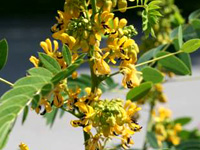Senna (Cassia augustifolia)

Introduction :
Senna is used in medicine as a cathartic, known from very old days for its laxative properties. It is well accepted in allopathic as well as unani drug systems.
Cultivation parameters :
Soil and Climate :
The crop can thrive on a variety of soils, but is largely grown on red loams, alluvial loams and the rich clayey fields. It is sensitive water- logging. Senna is a sun-loving crop and requires bright sunshine. Dry summer with moderate temperature is ideal for cultivation. It cannot survive at very low temperature. Ideal temperature should be between 300 to 350 C. and rainfall should be between 25 to 40 cm.
Altitude :
It can be grown upto an altitude of 600 to 900 meters.
Cultivation Details :
Type of propagation :
The crop is raised from seeds. Since the seeds have a hard and tough seed-coat, soaking the seeds for 10-12 hours before sowing is been reported to give 100% germination. About 20 kg of seeds are required to cover a hectare of land.
Time of cultivation :
In the month of February –March in northern India and in southern India, during October- November i.e. after rains.
Land Preparation and cultivation :
Before sowing, the land is ploughed twice, harrowed and leveled. Normally sowing is done by broadcasting method. The seeds are sown thinly in lines, 30-40 cm apart and at 1.5 to 2.0 cm depth. Soil moisture must be enough for germination, even though it is grown in dry fields. Germination is completed within a weak. Delay in sowing of seeds reduces the vegetative phase and ultimately, affects the yield of drug. The plants are allowed to grow for about five months till the growth of flower stalk occurs.
Irrigation :
It is grown as semi-irrigated or light-irrigated crop, though 5-6 irrigations increase the herb yield, about 2-3 weedings in the beginning and sufficient to raise the crop.
Harvesting :
Younger leaves and pods contain high sennoside content, hence to obtain desired level of biomass, pluking is done after 2-3 months of sowing. Harvesting of leaves is done in three stages. The first pluking is done when the leaflets are thick, full grown and greenish in colour. After one month of this collection, second pluking is done and last pluking is carried out after 4-6 weaks of second collection. The entire plants are uprooted after thirs pluking. It is observed that the contents of sennosides in leaves is maximum, when they are fully grown and goes on decreasing along with maturation of pods.
Pre-processing :
After collection, leaflets are dried in well-ventilated drying shade, or indoor by spreading them in thin layers. Within 7-10 days drying takes place and leaves show yellowish green colour.
Yield :
Under irrigated and better management practice about 1200 kg. of dried leaves per hectare are obtained. On rainfed land, an average of 500 to 700 kg. of drugs per hectare is procured.
Approximate economics of cultivation :
1st year |
Rs. |
Preparation of land
Cost of seeds
Sowing of seeds
Manure/ fertilizer
Irrigation
Weeding/ hoeing
Picking of leaves and pods
Drying and packing
Miscellaneous expenditure |
1000
900
300
1500
500
1200
2000
500
1100
|
Total |
9000 |
Returns :
Yield of leaves and pods –12Qtl.
Value of 12 Qtl leaves and pods at Rs. 25/ kg. = 30,000
Net profit = 21,000
Source :
- Cultivation of medicinal and aromatic crops by A.A.Farooqi and B.S.Sreeramu.
- Cultivation of medicinal plants by Dr. C.K.Kokate, Dr. A.S.Gokhle and Prof. S.B.Gokhle
|

